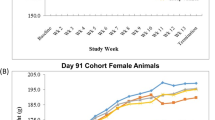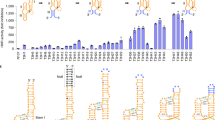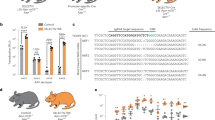Abstract
Adenovirus (Ad)-mediated gene delivery is a promising approach for genetic manipulation of the vasculature and is being used in both preclinical models and clinical trials. However, safety concerns relating to infection of nontarget tissue and the poor infectivity of vascular cells compared to other cell types necessitates Ad vector refinement. Here, we combine a transductional targeting approach to improve vascular cell infectivity through RGD peptide insertion into adenovirus fibers, combined with transcriptional targeting to endothelial cells using a ≈1 kb fragment of the fms-like tyrosine kinase receptor-1 (FLT-1) promoter. Single- and double-modified vectors were characterized in human cell lines that either support or have silenced FLT-1 expression. In rat hepatocytes and endothelial cells, the double modification substantially shifted transduction profiles toward vascular endothelial cells. Furthermore, in intact aortae derived from spontaneously hypertensive rats that display enhanced αv integrin expression on dysfunctional endothelium, enhanced levels of transduction were observed using the double-modified vector but not in aortae derived from normotensive control rats. Our data indicate that Ad-mediated transduction can be beneficially modified in vitro and in vivo by combining fiber modification and a cell-selective promoter within a single-component vector system.
This is a preview of subscription content, access via your institution
Access options
Subscribe to this journal
Receive 12 print issues and online access
$259.00 per year
only $21.58 per issue
Buy this article
- Purchase on Springer Link
- Instant access to full article PDF
Prices may be subject to local taxes which are calculated during checkout




Similar content being viewed by others
References
Havenga MJE et al. Improved adenovirus vectors for infection of cardiovascular tissues. J Virol 2001; 75: 3335–3342.
Havenga M et al. Exploiting the natural diversity in adenovirus tropism for therapy and prevention of disease. Virology 2002; 76: 4612–4620.
Reynolds PN et al. A targetable, injectable adenoviral vector for selective gene delivery to pulmonary endothelium in vivo. Mol Ther 2000; 2: 562–578.
Bartlett JS, Kleinschmidt J, Boucher RC, Samulski RJ . Targeted adeno-associated virus vector transduction of non-permissive cells mediated by a bi-specific F(ab'gamma)(2) antibody. Nat Biotech 1999; 17: 181–186.
Nicklin S, Baker A . Tropism-modified adenovirus and adeno-associated viral vectors for gene therapy. Curr Gene Ther 2002; 2: 273–293.
Dmitriev I et al. An adenovirus vector with genetically modified fibers demonstrates expanded tropism via utilization of a coxsackievirus and adenovirus receptor-independent cell entry mechanism. J Virol 1998; 72: 9706–9713.
Reynolds PN, Dmitriev I, Curiel DT . Insertion of an RGD motif into the HI loop of adenovirus fiber protein alters the distribution of transgene expression of the systemically administered vector. Gene Therapy 1999; 6: 1336–1339.
Shi W, Bartlett JS . RGD inclusion in VP3 provides adeno-associated virus type 2 (AAV2)-based vectors with a heparan sulfate-independent cell entry mechanism. Mol Ther 2003; 7: 515–525.
Pasqualini R, Koivunen E, Ruoslahti E . A peptide isolated from phage display libraries is a structural and functional mimic of an RGD-binding site on integrins. J Cell Biol 1995; 130: 1189–1196.
Bergelson JM et al. Isolation of a common receptor for coxsackie B viruses and adenoviruses 2 and 5. Science 1997; 275: 1320–1323.
Tomko RP, Xu R, Philipson L . HCAR and MCAR: The human and mouse cellular receptors for subgroup C adenoviruses and group B coxsackieviruses. Proc Natl Acad Sci USA 1997; 94: 3352–3356.
Summerford C, Samulski RJ . Membrane-associated heparan sulfate proteoglycan is a receptor for adeno-associated virus type 2 virions. J Virol 1998; 72: 1438–1445.
Hiltunen MO et al. Biodistribution of adenoviral vector to nontarget tissues after local in vivo gene transfer to arterial wall using intravascular and periadventitial gene delivery methods. FASEB J 2000; 14: 2230–2236.
Nagi P et al. Development of a therapuetic adenoviral vector for cholangiocarcinoma combining tumor-restricted gene expression and infectivity enhancement. J Gastrointest Surg 2003; 7: 364–371.
Nicklin SA et al. Analysis of cell-specific promoters for viral gene therapy targeted at the vascular endothelium. Hypertension 2001; 38: 65–70.
Reynolds P et al. Combined transductional and transcriptional targeting improves the specificity of transgene expression in vivo. Nat Biotechnol 2001; 19: 833–842.
Bauerschmitz G et al. The flt-1 promoter for transcriptional targeting in teratocarcinoma. Cancer Res 2002; 62: 1271–1274.
Nicklin SA et al. Transductional and transcriptional targeting of cancer cells using genetically-engineered viral vectors. Cancer Lett 2003; 201: 165–173.
Kerr S et al. Superoxide anion production is increased in a model of genetic hypertension: The role of endothelial nitric oxide synthase and superoxide dismutase isoforms. Hypertension 1999; 33: 1353–1358.
Jeffs B et al. Sensitivity to cerebral ischaemic insult in a rat model of stroke is determined by a single genetic locus. Nat Genet 1997; 16: 364–367.
Dominiczak A et al. Left ventricular hypertophy and arterial blood pressure in experimental models of hypertension. Adv Exp Med Biol 1997; 432: 23–33.
Fennell JP et al. Adenovirus-mediated overexpression of extracellular superoxide dismutase improves endothelial dysfunction in a rat model of hypertension. Gene Therapy 2002; 9: 110–117.
Asahara T et al. Local delivery of vascular endothelial growth factor accelerates reendothelialization and attenuates intimal hyperplasia in balloon-injured rat carotid artery. Circulation 1995; 91: 2793–2801.
Wen S et al. Second-generation adenoviral vectors do not prevent rapid loss of transgene expression and vector DNA from the arterial wall. Arterioscl Thromb Vasc Biol 2000; 20: 1452–1458.
Intengan HD, Thibault G, Li J-S, Schiffrin EL . Resistance artery mechanics, structure, and extracellular components in spontaneously hypertensive rats: Effects of angiotensin receptor antagonism and converting enzyme inhibition. Circulation 1999; 100: 2267–2275.
Nicklin SA, Baker AH . Simple methods for preparing recombinant adenoviruses for high efficiency transduction of vascular cells. In: Baker AH (ed) Vascular Disease: Molecular Biology and Gene Transfer Protocols (Methods in Molecular Medicine). Humana Press: New York, 1999.
Nicklin SA et al. Ablating adenovirus type 5 fiber-CAR binding and HI loop insertion of the SIGYPLP peptide generate an endothelial cell-selective adenovirus. Mol Ther 2001; 4: 534–542.
Acknowledgements
We thank Margaret Cunningham and Nicola Britton for technical assistance and the Biotechnology and Biological Sciences Research Council (17GTH12582 and E17190 to AHB) and British Heart Foundation (PG03/031 to AHB) for financial support.
Author information
Authors and Affiliations
Rights and permissions
About this article
Cite this article
Work, L., Ritchie, N., Nicklin, S. et al. Dual targeting of gene delivery by genetic modification of adenovirus serotype 5 fibers and cell-selective transcriptional control. Gene Ther 11, 1296–1300 (2004). https://doi.org/10.1038/sj.gt.3302292
Received:
Accepted:
Published:
Issue Date:
DOI: https://doi.org/10.1038/sj.gt.3302292
Keywords
This article is cited by
-
A plant derived multifunctional tool for nanobiotechnology based on Tomato bushy stunt virus
Transgenic Research (2013)
-
CRAdRGDflt-IL24 virotherapy in combination with chemotherapy of experimental glioma
Cancer Gene Therapy (2009)
-
Gene therapy targeting to tumor endothelium
Cancer Gene Therapy (2007)



